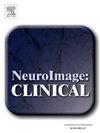Atypical alpha oscillatory EEG dynamics in children with Angelman syndrome
IF 3.6
2区 医学
Q2 NEUROIMAGING
引用次数: 0
Abstract
Objectives
Biomarkers of atypical brain development are crucial for advancing clinical trials and guiding therapeutic interventions in Angelman syndrome (AS). Electroencephalography (EEG) captures well-characterized developmental changes in peak alpha frequency (PAF) that reflect underlying neural circuit maturation and may provide a sensitive metric for mapping atypical neural trajectories in AS.
Method
We analyzed 159 EEG recordings from 95 children with AS (ages 1–15 years) and 185 age-matched typically developing (TD) controls. PAF was quantified using a well-established curve-fitting method applied to 1/f-corrected power spectra. To validate robustness, we further evaluated PAF using an alternative prominence-based peak detection approach across varying detection thresholds.
Results
Significant disruptions in PAF were evident in children with AS. While over 90% of EEGs from TD children exhibited a clear alpha peak, fewer than 50% of EEGs from children with AS showed a detectable PAF. Furthermore, when PAF was present, its frequency was significantly lower in AS children and did not show the typical age-related increases observed in TD children. Validation analyses confirmed consistently lower rates of PAF detection in AS across varying sensitivity thresholds, demonstrating the robustness of these results.
Conclusions
The absence and lower frequency of alpha peaks in Angelman syndrome indicate that PAF is a developmentally sensitive marker of disrupted neural maturation in this population. Further research is needed to clarify how PAF emergence and shifts relate to longitudinal developmental trajectories and specific clinical phenotypes. Nonetheless, PAF shows promise as an objective, quantitative biomarker of neural circuit dynamics that can enhance clinical‐trial endpoints by indexing underlying brain function. Future analyses will examine inter‐individual variability in PAF among AS participants to uncover mechanistic pathways that may inform targeted therapeutic strategies.
Angelman综合征患儿的非典型α振荡脑电图动力学
目的研究非典型脑发育的生物标志物对推进Angelman综合征(AS)的临床试验和指导治疗干预具有重要意义。脑电图(EEG)捕获了表征良好的α峰频率(PAF)的发育变化,反映了潜在的神经回路成熟,并可能为绘制非典型神经轨迹提供敏感指标。方法分析95例1 ~ 15岁AS患儿和185例年龄匹配的典型发育(TD)对照者的159份脑电图记录。采用一种行之有效的曲线拟合方法对1/f校正后的功率谱进行了量化。为了验证鲁棒性,我们在不同的检测阈值上使用另一种基于突出的峰值检测方法进一步评估了PAF。结果AS患儿PAF明显紊乱。虽然超过90%的TD儿童的脑电图显示出明显的α峰,但不到50%的AS儿童的脑电图显示可检测到的PAF。此外,当PAF存在时,其频率在AS儿童中显着降低,并且在TD儿童中未显示出典型的年龄相关增加。验证分析证实,在不同的灵敏度阈值中,AS的PAF检出率始终较低,证明了这些结果的稳健性。结论Angelman综合征中α峰的缺失和频率较低表明PAF是该人群神经成熟中断的发育敏感标志物。需要进一步的研究来阐明PAF的出现和转移与纵向发育轨迹和特定临床表型的关系。尽管如此,PAF有望作为神经回路动力学的客观定量生物标志物,通过索引潜在的脑功能来提高临床试验终点。未来的分析将检查AS参与者中PAF的个体间变异性,以揭示可能为靶向治疗策略提供信息的机制途径。
本文章由计算机程序翻译,如有差异,请以英文原文为准。
求助全文
约1分钟内获得全文
求助全文
来源期刊

Neuroimage-Clinical
NEUROIMAGING-
CiteScore
7.50
自引率
4.80%
发文量
368
审稿时长
52 days
期刊介绍:
NeuroImage: Clinical, a journal of diseases, disorders and syndromes involving the Nervous System, provides a vehicle for communicating important advances in the study of abnormal structure-function relationships of the human nervous system based on imaging.
The focus of NeuroImage: Clinical is on defining changes to the brain associated with primary neurologic and psychiatric diseases and disorders of the nervous system as well as behavioral syndromes and developmental conditions. The main criterion for judging papers is the extent of scientific advancement in the understanding of the pathophysiologic mechanisms of diseases and disorders, in identification of functional models that link clinical signs and symptoms with brain function and in the creation of image based tools applicable to a broad range of clinical needs including diagnosis, monitoring and tracking of illness, predicting therapeutic response and development of new treatments. Papers dealing with structure and function in animal models will also be considered if they reveal mechanisms that can be readily translated to human conditions.
 求助内容:
求助内容: 应助结果提醒方式:
应助结果提醒方式:


